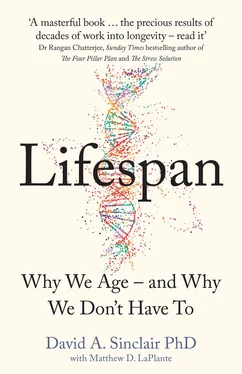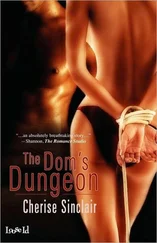Italian researchers found after studying 4,000 elderly people that if you make it to age 105, the risk of death effectively plateaus from one birthday to the next, the odds of dying in the next year becoming approximately fifty-fifty. E. Barbi, F. Lagona, M. Marsili, et al., “The Plateau of Human Mortality: Demography of Longevity Pioneers,” Science 360, no. 396 (June 29, 2018): 1459–61, http://science.sciencemag.org/content/360/6396/1459.
“If people live on average to 80 or 90, like they do now, then the very long lived make it to 110 or 120,” says Siegfried Hekimi, professor of genetics at McGill University in Canada. “So if the average lifespan keeps expanding, that would mean the long-lived would live even longer, beyond 115 years”; A. Park, “There’s No Known Limit to How Long Humans Can Live, Scientists Say,” Time , June 28, 2017, http://time.com/4835763/how-long-can-humans-live/.
“Any sufficiently advanced technology is indistinguishable from magic.” “Arthur C. Clarke,” Wikiquote, https://en.wikiquote.org/wiki/Arthur_C._Clarke.
D. Damer and D. Deamer, “Coupled Phases and Combinatorial Selection in Fluctuating Hydrothermal Pools: A Scenario to Guide Experimental Approaches to the Origin of Cellular Life,” Life 5, no. 1 (2015): 872–87, https://www.mdpi.com/2075-1729/5/1/872.
According to precise radiological and geological readings and recent discoveries about the early chemistry of life, this is an accurate picture of how the inanimate was animated and life took hold. M. J. Van Kranendonk, D. W. Deamer, and T. Djokic, “Life on Earth Came from a Hot Volcanic Pool, Not the Sea, New Evidence Suggests,” Scientific American , August 2017, https://www.scientificamerican.com/article/life-on-earth-came-from-a-hot-volcanic-pool-not-the-sea-new-evidence-suggests/.
J. B. Iorgulescu, M. Harary, C. K. Zogg, et al., “Improved Risk-Adjusted Survival for Melanoma Brain Metastases in the Era of Checkpoint Blockade Immunotherapies: Results from a National Cohort,” Cancer Immunology Research , 6, no. 9 (September 2018): 1039–45, http://cancerimmunolres.aacrjournals.org/content/6/9/1039.long; R. L. Siegel, K. D. Miller, and A. Jemal, “Cancer Statistics, 2019,” CA: A Cancer Journal for Clinicians 69, no. 1 (January–February 2019): 7–34, https://onlinelibrary.wiley.com/doi/full/10.3322/caac.21551.
As far back as Aristotle, scientists and philosophers have struggled to resolve the enigma of aging, the authors wrote. D. Fabian and T. Flatt, “The Evolution of Aging,” Nature Education Knowledge 3, no. 10 (2011): 9, https://www.nature.com/scitable/knowledge/library/the-evolution-of-aging-23651151.
A bat from Siberia set a world record when it reached 41 years of age. R. Locke, “The Oldest Bat: Longest-Lived Mammals Offer Clues to Better Aging in Humans,” BATS Magazine 24, no. 2 (Summer 2006): 13–14, http://www.batcon.org/resources/media-education/bats-magazine/bat_article/152.
Small colonies of lizards on a series of Caribbean islands were likely to explore islands where there weren’t predators, while less adventurous animals survived better when predators were present. O. Lapiedra, T. W. Schoener, M. Leal, et al., “Predator-Driven Natural Selection on Risk-Taking Behavior in Anole Lizards,” Science 360, no. 3692 (June 1, 2018): 1017–20, http://science.sciencemag.org/content/360/6392/1017.
Richard Dawkins eloquently made this point in River Out of Eden , arguing that primitive societies don’t have a place in science, using as an example their belief the moon is an old calabash tossed into the sky. R. Dawkins, River Out of Eden (New York: Basic Books, 1995).
See “The Scale of Things” at the end of this book.
Szilard spent his last years as a fellow of the Salk Institute for Biological Studies in La Jolla, California, as a resident fellow. He lived in a bungalow on the property of the Hotel del Charro and died on May 30, 1964.
R. Anderson, “Ionizing Radiation and Aging: Rejuvenating an Old Idea,” Aging 1, no. 11 (November 17, 2009): 887–902, https://www.ncbi.nlm.nih.gov/pmc/articles/PMC2815743/.
L. E. Orgel, “The Maintenance of the Accuracy of Protein Synthesis and Its Relevance to Ageing,” Proceedings of the National Academy of Sciences of the United States of America 49, no. 4 (April 1963): 517–21, https://www.ncbi.nlm.nih.gov/pmc/articles/PMC299893/.
Harman concluded that the diseases related to aging, as well as aging itself, stem fundamentally from “the deleterious side attacks of free-radicals on cell constituents and on the connective tissues.” The source of the free radicals, he continued, was “molecular oxygen catalyzed in the cell by the oxidative enzymes” and metal traces. D. Harman, “Aging: A Theory Based on Free Radical and Radiation Chemistry,” Journal of Gerontology 11, no. 3 (July 1, 1956): 298–300, https://academic.oup.com/geronj/article-abstract/11/3/298/616585?redirectedFrom=fulltext.
Nutraceuticals World predicts that a rising appetite for synthetic antioxidants at the same time as a fall in costs, combined with increasing demand for them by food and beverage companies, will power market growth for the next few years. “Global Antioxidants Market Expected to Reach $4.5 Billion by 2022,” Nutraceuticals World , January 26, 2017, https://www.nutraceuticalsworld.com/contents/view_breaking-news/2017-01-26/global-antioxidants-market-expected-to-reach-45-billion-by-2022
The sharp growth in demand for drinks with a health benefit, a beverage industry website finds, goes hand in hand with consumers wanting ingredients they value. A. Del Buono, “Consumers’ Understanding of Antioxidants Grows,” Beverage Industry , January 16, 2018, https://www.bevindustry.com/articles/90832-consumers-understanding-of-antioxidants-grows?v=preview.
I. Martincorena, J. C. Fowler, A. Wabik, et al., “Somatic Mutant Clones Colonize the Human Esophagus with Age,” Science 362, no. 6417 (November 23, 2018): 911–17, https://www.ncbi.nlm.nih.gov/pubmed/30337457.
The authors concluded that their data “calls into serious question the hypothesis that alterations in oxidative damage/stress play a role in the longevity of mice.” V. I. Pérez, A. Bokov, H. Van Remmen, et al., “Is the Oxidative Stress Theory of Aging Dead?,” Biochimica et Biophysica Acta 1790, no. 10 (October 2009): 1005–14, https://www.ncbi.nlm.nih.gov/pmc/articles/PMC2789432/.
A. P. Gomes, N. L. Price, A. J. Ling, et al., “Declining NAD(+) Induces a Pseudohypoxic State Disrupting Nuclear-Mitochondrial Communication During Aging,” Cell 155, no. 7 (December 19, 2013): 1624–38, https://www.ncbi.nlm.nih.gov/pubmed/24360282.
W. Lanouette and B. Silard, Genius in the Shadows: A Biography of Leo Szilard: The Man Behind the Bomb (New York: Skyhorse Publishing, 1992).
According to the NIH fact sheet, “clones created from a cell taken from an adult might have chromosomes that are already shorter than normal, which may condemn the clones’ cells to a shorter life span.” “Cloning,” National Human Genome Research Institute, March 21, 2017, https://www.genome.gov/25020028/cloning-fact-sheet/.
Читать дальше












